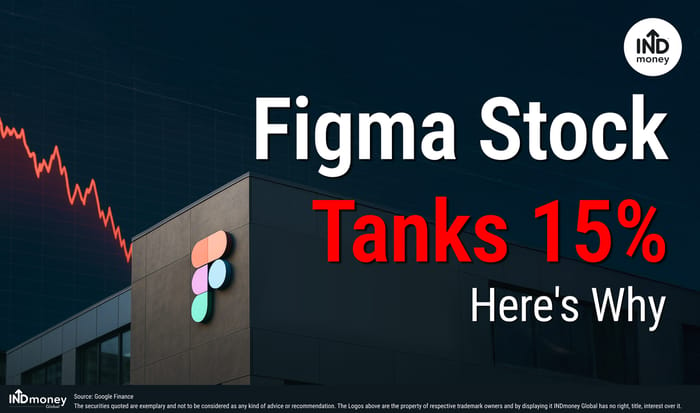
- Figma’s Key Financials Behind the Headlines
- Why Did the Figma Stock Drop Despite the Strong Numbers?
- Strategic Moves and the Road Ahead for Figma
Figma, the design-software darling that took Wall Street by storm with its blockbuster IPO, hit its first real test as a public company and stumbled. Figma Stock fell nearly 15% in after-hours trading as per Google Finance after its debut earnings call, despite reporting robust revenue growth and swing to profitability. For a stock that had been riding a wave of Silicon Valley hype, the sudden pullback was a reminder that the market has little patience for anything less than perfection.
Let’s break down with this blog what exactly went on: the numbers behind the headlines, why investors reacted so harshly, and what this means for Figma’s long-term story.
Figma’s Key Financials Behind the Headlines
| Metric | Q2 2025 | YoY Change |
| Revenue | $249.6 million | +41 % |
| GAAP Net Income | $28.2 million | From a $827.9 million loss |
| Non-GAAP Net Income | $19.8 million | Significant gain |
Source: Figma Q2 Earnings Report
Figma’s Guidance for Q3 2025
| Metric | Q3 2025 (Expected) | YoY Change |
| Q3 Revenue Guidance | $263-265 million | ~33 % |
| Full-Year Revenue Outlook | $1.021-1.025 billion | ~37 % |
Source: Figma Q2 Earnings Report
At first glance, this looks like the perfect earnings debut. Revenue surged 41% YoY, comfortably ahead of consensus estimates. Profitability, which was once a distant dream for Figma, finally materialized with both GAAP and non-GAAP net income swinging into the green. Strong operating cash flow and a $1.6 billion cash reserve added to the impression of a company in control of its destiny.
The guidance, too, was encouraging: management expects 33% YoY growth next quarter and 37% YoY growth for the full year, above what analysts had estimated. For most companies, this would be a win. But Figma isn’t “most companies” and therein lies the problem.
Why Did the Figma Stock Drop Despite the Strong Numbers?
- Sky-high expectations: When your IPO debut delivers a 250% valuation surge, the bar is set unreasonably high. Figma met consensus estimates but didn’t deliver the kind of surprise that investors had hoped for.
- Valuation worries: Even after the correction, Figma trades at very high multiples compared to its SaaS peers.
- Profit miss: The company swung to profit, yes, but earnings per share still landed below analyst forecasts. In a market that rewards efficiency and high margins, even a small miss can look like a red flag.
- Heavy AI spending: CEO Dylan Field highlighted aggressive investments in artificial intelligence, calling them central to Figma’s evolution. While exciting for the future, these moves raise questions about near-term margins, as gross margins are expected to dip from the current 90% levels.
- Upcoming share unlock: Management disclosed an early lock-up expiry in September, allowing insiders and early investors to sell shares. That looming supply overhang alone can spook traders into heading for the exits early.
- Post-IPO cool-off: It’s not unusual for newly listed tech stocks to see volatility once the dust settles. After soaring as high as $142 from a $33 IPO price, Figma was already on shaky footing heading into this report.
Strategic Moves and the Road Ahead for Figma
While the market punished the stock, management struck an optimistic tone. Figma continues to double down on product innovation, including new launches like Figma Make, Draw, Sites, and Buzz, along with acquisitions such as Modyfi and Payload. The company also boasts a healthy net dollar retention rate of 129%, underscoring the stickiness of its platform among enterprise clients.
Most importantly, Dylan Field positioned AI as the core of Figma’s long-term roadmap, arguing that investments today will accelerate design cycles and expand its competitive moat tomorrow. For believers in the digitization of design, this is where the real story lies.
The next few quarters will determine whether Figma can transform investor perception from “hyped IPO” to “dependable performer.” Delivering sustained profitability while proving that AI bets can pay off will be the key. For now, the sell-off looks less like a collapse and more like a reality check: the market is reminding Figma that on Wall Street, growth alone isn’t enough anymore.
Disclaimer:
The content is meant for education and general information purposes only. Investments in the securities market are subject to market risks, read all the related documents carefully before investing. Past performance is not indicative of future returns. The securities quoted are exemplary and are not a recommendation. This in no way is to be construed as financial advice or a recommendation to invest in any specific stock or financial instrument.The figures mentioned in this article are indicative and for general informational purposes only. Readers are encouraged to verify the exact numbers and financial data from official sources such as company filings, earnings reports, and financial news platforms. The Company strongly encourages its users/viewers to conduct their own research, and consult with a registered financial advisor before making any investment decisions. All disputes in relation to the content would not have access to an exchange investor redressal forum or arbitration mechanism. Registered office address: Office No. 507, 5th Floor, Pragya II, Block 15-C1, Zone-1, Road No. 11, Processing Area, GIFT SEZ, GIFT City, Gandhinagar – 382355. IFSCA Broker-Dealer Registration No. IFSC/BD/2023-24/0016, IFSCA DP Reg No: IFSC/DP/2023-24/010